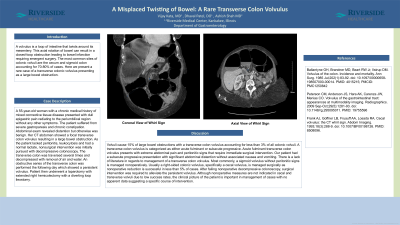Sunday Poster Session
Category: Colon
P0299 - A Misplaced Twisting of Bowel: A Transverse Colon Volvulus
Sunday, October 22, 2023
3:30 PM - 7:00 PM PT
Location: Exhibit Hall

Has Audio
- VK
Vijay Kata, MD, MS
Riverside Medical Center
Kankakee, IL
Presenting Author(s)
Vijay Kata, MD, MS, Dhaval Patel, DO, Nikhil Bhargava, DO, Ashish Shah, MD
Riverside Medical Center, Kankakee, IL
Introduction: A volvulus is a loop of intestine that twists around its mesentery. This axial rotation of bowel can result in a closed-loop obstruction leading to bowel infarction requiring emergent surgery. The most common sites of colonic volvulus are the cecum and sigmoid colon accounting for 70-80% of cases. Here we present a rare case of a transverse colonic volvulus presenting as large bowel obstruction .
Case Description/Methods: A 55-year-old woman with a chronic medical history of mixed connective tissue disease presented with dull epigastric pain radiating to the periumbilical region without any other symptoms.Patient suffered from severe gastroparesis and chronic constipation. Abdominal exam revealed distention otherwise was benign. Her CT abdomen showed a focal transverse colon volvulus resulting in a large bowel obstruction. As the patient lacked peritonitis, leukocytosis and lactate was normal, nonsurgical intervention was initially pursued with decompressive colonoscopy. The transverse colon was traversed several times and decompressed with removal of air and water. An obstructive series of transverse colon was performed the following day which showed a persistent volvulus. Patient then underwent a laparotomy with extended right hemicolectomy with a diverting loop ileostomy.
Discussion: Volvuli cause 15% of large bowel obstructions with a transverse colon volvulus accounting for less than 3% of all colonic volvuli. A transverse colon volvulus is categorized as either acute fulminant or subacute progressive. Acute fulminant transverse colon volvulus presents with extreme abdominal pain and peritonitic signs that require immediate surgical intervention. Our patient had a subacute progressive presentation with significant abdominal distention without associated nausea and vomiting. There is a lack of literature in regards to management of a transverse colon volvulus. Most commonly, a sigmoid volvulus without peritonitic signs is managed nonoperatively. Usually a right-sided colonic volvulus, specifically a cecal volvulus, is managed surgically as nonoperative reduction is successful in less than 5% of cases. After failing nonoperative decompressive colonoscopy, surgical intervention was required to alleviate the persistent volvulus. Although nonoperative measures are not indicated in cecal and transverse volvuli due to low success rates, the clinical picture of the patient is important in management of cases with no significant data.

Disclosures:
Vijay Kata, MD, MS, Dhaval Patel, DO, Nikhil Bhargava, DO, Ashish Shah, MD. P0299 - A Misplaced Twisting of Bowel: A Transverse Colon Volvulus, ACG 2023 Annual Scientific Meeting Abstracts. Vancouver, BC, Canada: American College of Gastroenterology.
Riverside Medical Center, Kankakee, IL
Introduction: A volvulus is a loop of intestine that twists around its mesentery. This axial rotation of bowel can result in a closed-loop obstruction leading to bowel infarction requiring emergent surgery. The most common sites of colonic volvulus are the cecum and sigmoid colon accounting for 70-80% of cases. Here we present a rare case of a transverse colonic volvulus presenting as large bowel obstruction .
Case Description/Methods: A 55-year-old woman with a chronic medical history of mixed connective tissue disease presented with dull epigastric pain radiating to the periumbilical region without any other symptoms.Patient suffered from severe gastroparesis and chronic constipation. Abdominal exam revealed distention otherwise was benign. Her CT abdomen showed a focal transverse colon volvulus resulting in a large bowel obstruction. As the patient lacked peritonitis, leukocytosis and lactate was normal, nonsurgical intervention was initially pursued with decompressive colonoscopy. The transverse colon was traversed several times and decompressed with removal of air and water. An obstructive series of transverse colon was performed the following day which showed a persistent volvulus. Patient then underwent a laparotomy with extended right hemicolectomy with a diverting loop ileostomy.
Discussion: Volvuli cause 15% of large bowel obstructions with a transverse colon volvulus accounting for less than 3% of all colonic volvuli. A transverse colon volvulus is categorized as either acute fulminant or subacute progressive. Acute fulminant transverse colon volvulus presents with extreme abdominal pain and peritonitic signs that require immediate surgical intervention. Our patient had a subacute progressive presentation with significant abdominal distention without associated nausea and vomiting. There is a lack of literature in regards to management of a transverse colon volvulus. Most commonly, a sigmoid volvulus without peritonitic signs is managed nonoperatively. Usually a right-sided colonic volvulus, specifically a cecal volvulus, is managed surgically as nonoperative reduction is successful in less than 5% of cases. After failing nonoperative decompressive colonoscopy, surgical intervention was required to alleviate the persistent volvulus. Although nonoperative measures are not indicated in cecal and transverse volvuli due to low success rates, the clinical picture of the patient is important in management of cases with no significant data.

Figure: A. Axial View of Transverse Colon Volvulus
B. Coronal View of Transverse Colon Volvulus
B. Coronal View of Transverse Colon Volvulus
Disclosures:
Vijay Kata indicated no relevant financial relationships.
Dhaval Patel indicated no relevant financial relationships.
Nikhil Bhargava indicated no relevant financial relationships.
Ashish Shah indicated no relevant financial relationships.
Vijay Kata, MD, MS, Dhaval Patel, DO, Nikhil Bhargava, DO, Ashish Shah, MD. P0299 - A Misplaced Twisting of Bowel: A Transverse Colon Volvulus, ACG 2023 Annual Scientific Meeting Abstracts. Vancouver, BC, Canada: American College of Gastroenterology.
